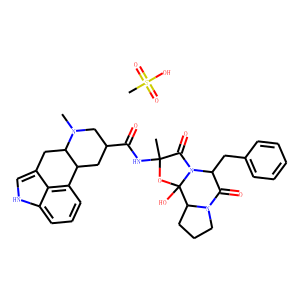| IUPAC Name | (6aR,9R)-N-[(1S,2S,4R,7S)-7-benzyl-2-hydroxy-4-methyl-5,8-dioxo-3-oxa-6,9-diazatricyclo[7.3.0.02,6]dodecan-4-yl]-7-methyl-6,6a,8,9,10,10a-hexahydro-4H-indolo[4,3-fg]quinoline-9-carboxamide;methanesulfonic acid |
| InChI | InChI=1S/C33H37N5O5.CH4O3S/c1-32(35-29(39)21-15-23-22-10-6-11-24-28(22)20(17-34-24)16-25(23)36(2)18-21)31(41)38-26(14-19-8-4-3-5-9-19)30(40)37-13-7-12-27(37)33(38,42)43-32;1-5(2,3)4/h3-6,8-11,17,21,23,25-27,34,42H,7,12-16,18H2,1-2H3,(H,35,39);1H3,(H,2,3,4)/t21-,23?,25-,26+,27+,32-,33+;/m1./s1 |
| Reference | [1]. Br J Clin Pract Suppl. 1985 Jun;39:21-4.<br />
The clinical pharmacology of dihydroergotoxine mesylate (Hydergine).<br />
James IM.<br />
PMID: 3929811 [Indexed for MEDLINE]<br />
<br />
[2]. Gerontology. 1981;27(3):152-7. doi: 10.1159/000212464.<br />
Bromocriptine, dihydroergotoxine and sleep in rats: effects of repeated administration.<br />
Radulovacki M, Brodie M, Walovitch R, Yanik G.<br />
Bromocriptine mesylate (7.5 mg/kg, i.p.) and dihydroergotoxine mesylate (DHET); 3 mg/kg, i.p.) were administered 4 times at 9-hour intervals within a 27-hour period to rats polygraphically recorded for 84 h. Administration of bromocriptine resulted in increased wakefulness and reduced slow-wave sleep (SWS) and rapid eye movement sleep (REM) during the 0- to 36-hour period. Reduction of SWS or REM during this time period was not followed by a rebound of SWS or REM during the next 36- to 84-hour period. In addition, there was a significant reduction of SWS during the entire 0- to 84-hour period. Administration of DHET to rats did not significantly affect sleep although there was a tendency for wakefulness to increase and for SWS and REM to decrease. It appears that the effects of repeated administration of the two ergot compounds on the sleep-wakefulness cycle in rats may be indicative of the drugs' role in fulfillment of sleep 'need'.<br />
DOI: 10.1159/000212464 PMID: 7239174 [Indexed for MEDLINE]<br />
<br />
[3]. Br J Clin Pharmacol. 1985 Dec;20(6):603-9. doi: 10.1111/j.1365-2125.1985.tb05118.x.<br />
Absorption kinetics of dihydroergotoxine following oral administration to man.<br />
Woodcock BG, Rietbrock N, Loh W, Habedank WD.<br />
The absorption characteristics of dihydroergotoxine administered as an oral solution, tablet and retard capsule have been determined in a randomised cross-over investigation in 12 healthy males. The plasma concentrations of dihydroergotoxine produced by the three preparations, measured using a specific and sensitive radioimmuno-assay method over 24 h, exceeded 200 pg ml-1 for approximately 5 h and decayed in a biphasic manner with a slowest measured half-life of 12-14 h. The retard capsule differs from the other two preparations in having a low Cmax (50% of that recorded for the solution) and a clearly defined plateau. The bioavailability of the retard capsule was similar to that for the solution indicating that first-pass metabolism is not significantly increased following a three-fold prolongation in the absorption rate constant. The 20-40% greater bioavailability of dihydroergotoxine solution and retard capsule in comparison with the standard tablet may be due to a reduced contact time with gastric secretions achieved by means of rapid absorption from the stomach (solution) or delayed release at pH 1.5 (retard capsule).<br />
DOI: 10.1111/j.1365-2125.1985.tb05118.x PMCID: PMC1400840 PMID: 4091992 [Indexed for MEDLINE]<br />
<br />
[4]. Gerontology. 1978;24 Suppl 1:66-70. doi: 10.1159/000212299.<br />
Effects of dihydroergotoxine mesylate on aging neurons in vitro.<br />
Nandy K, Schneider FH.<br />
C1300 mouse neuroblastoma cells gradually accumulate lipofuscin-like pigment when they are maintained in culture. Pigment was demonstrated by positive straining for acid phosphatase and with periodic acid-Schiff stain. Pigment was formation in cells was reduced by exposure of the cells to lower doses of dihydroergotoxine mesylate which also induced neurite formation and increased protein synthesis. Since lipofuscin appears to originate as a result of wear and tear within the cells, the drug probably exerts its beneficial effects by reducing the rate of intracellular wear and tear associated with aging.<br />
DOI: 10.1159/000212299 PMID: 22479 [Indexed for MEDLINE]<br />
<br />
[5]. Indian J Exp Biol. 1991 Jun;29(6):532-7.<br />
Effect of dihydroergotoxine, a cerebral vasodilator, on cognitive deficits induced by prenatal undernutrition and environmental impoverishment in young rats.<br />
Jaiswal AK(1), Upadhyay SN, Bhattacharya SK.<br />
Author information: (1)Department of Pharmacology, Institute of Medical Sciences, Banaras Hindu University, Varanasi, India.<br />
The study was conducted on 64 Charles Foster strain albino rats, which were equally distributed into 8 evenly matched groups, following a 2 x 2 x 2 factorial design, by varying three independent factors at two levels: nutrition–normal and undernutrition; environment–enrichment and impoverishment, and drug treatment–vehicle and dihydroergotoxine (3 mg/kg, i.p.). Prenatal undernutrition was induced by restricting the mother's food intake. The environmental enrichment/impoverishment and the vehicle/dihydroergotoxine treatments were given during the postweaning period of the pups. The rats were subjected to original and subsequent reversal brightness discrimination learning tests in a single unit T-maze at 8-9 weeks of age. Thereafter, the animals were tested for passive avoidance learning. The results indicate that undernutrition caused significant original and reversal discrimination learning, deficits whereas environmental deprivation attenuated only the original discrimination learning performance. Dihydroergotoxine treatment facilitated the learning performance of rats in both the original and reversal learning tests. Nutritional, environmental and dihydroergotoxine treatments had no effect on the retention of the passive avoidance learning, both at 24 hr and 1 week intervals. Dihydroergotoxine treatment attenuated the learning deficits induced by prenatal undernutrition. The results indicate that dihydroergotoxine is not likely to be useful in cognitive deficits, induced by malnutrition, though it facilitated learning acquisition, since it had no effect on retention.<br />
PMID: 1889826 [Indexed for MEDLINE]
|

